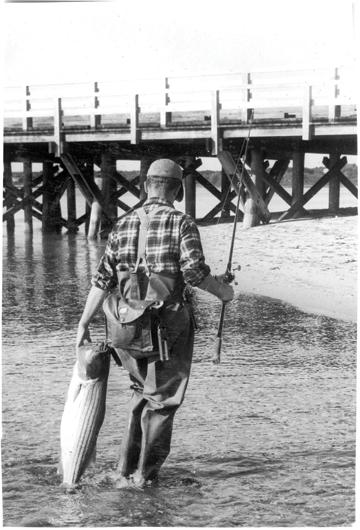On July 5, 1960 I fished a late tide at Squibnocket and Stonewall Beach with Dick Hathaway, Ted Henley, and a couple of other regulars. We were skunked and quit around midnight, but I still had some energy and went to Anthiers Bridge, where I caught a forty-eight-pound striped bass on a jointed swimming plug. This was a big fish, and a lot of people wanted to know where it came from. I told the truth, but nobody believed me. I’d been seen up-Island and it was assumed that’s where I’d caught it. I had the bridge to myself for the next couple of weeks. No one even bothered to look there, so sure were they that I was fabricating the truth.
Anthiers, or the Big Bridge, is such a heavily trafficked place that few people associate it with the kind of hush-hush, clandestine water that produces big bass, overlooking the fact that it drains Sengekontacket Pond and its multitudes of baitfish that stripers feast on. And that the bridge creates a shadow line where the bass can hide and ambush their quarry. Ideal striper conditions in other words.

When I lived in Edgartown, I spent many bass-filled nights at Anthiers, fishing downstream on both the incoming and falling tides, mostly with eelskin rigs whose big 8/0 hooks were sometimes straightened by very large fish. Then in the late 1960s my friends Al Reinfelder and Lou Palma introduced me to a new method that they had honed to a fine art on Long Island, where bridge fishing was illegal and where they had to keep one step ahead of the cops.
They developed a jig called the Alou Bait Tail, and we would cast it from the uptide side of Anthiers and let the current bounce it back toward us. Bass would hit when it reached the shadow line, and with heavy tackle we would try to hold their heads above water so they couldn’t swim under the bridge with the tide and cut us off. The thrashing sounds made by those lassoed fish were like Volkswagens falling into the water!
We tried the same method at the old Lagoon drawbridge, and it worked there also, but the bridge height made it too challenging to land the fish.
Bridges and shadow lines spell bass habitat. The Vineyard has five such bridges, including the Dike Bridge on Chappy, Anthiers in Edgartown, Little Bridge and Lagoon Bridge in Oak Bluffs, and Quitsa in Chilmark. You can catch stripers at all of them.



 2 comments
2 comments
Comments (2)